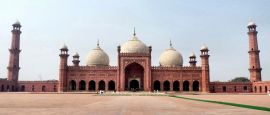Surrounded by the towering peaks of the Hindu Kush, Chitral Valley is a remote paradise famed for its pristine landscapes, traditional wooden architecture, and the unique Kalash tribes, whose colourful festivals and ancient customs offer a glimpse into a fascinating way of life. The valley is also noted for its hot springs and trout-filled rivers.
Pakistan things to see and do
Islamabad is Pakistan's modern and green capital. The Faisal Mosque, one of the largest mosques in the world, is an architectural marvel set against the backdrop of the Margalla Hills. Nature lovers can explore the serene Daman-e-Koh viewpoint or hike the Margalla Hills National Park trails. The Pakistan Monument and its adjoining museum provide an insightful glimpse into the nation's history and culture. For a relaxing day, visit the lush Rawal Lake, perfect for picnics or boating, or stroll through the picturesque Saidpur Village, a charming heritage spot.
Karachi is Pakistan's bustling economic hub, blending history, culture, and modernity. The Quaid-e-Azam's Mausoleum, a striking white marble monument, pays tribute to the founder of Pakistan. For history enthusiasts, the National Museum of Pakistan and Mohatta Palace Museum offer a glimpse into the region's rich past. For coastal charm, head to Clifton Beach or the more secluded Hawke's Bay, popular for its turtle nesting sites. Empress Market captures the vibrant local culture, while the upscale Dolmen Mall showcases Karachi's modern retail scene.
Lahore, the vibrant cultural capital of Pakistan, is a living museum of Mughal splendour and lively traditions. The UNESCO-listed Lahore Fort and Badshahi Mosque transport you to the grandeur of a bygone era, while the lush Shalimar Gardens showcase the artistry of Mughal landscaping. Lose yourself in the bustling bazaars of the Walled City, where historic gates and havelis whisper tales of centuries past. The towering Minar-e-Pakistan stands as a proud symbol of independence, while the Lahore Museum offers a journey through Pakistan's rich history. Don't miss Food Street, where every bite is a celebration of Lahore's legendary cuisine and hospitality.
Malam Jabba is Pakistan's premier ski resort and a year-round destination for adventure and nature lovers. Surrounded by snow-capped peaks and lush forests, it offers excellent skiing and snowboarding in winter, while summer brings opportunities for hiking, zip-lining, and chairlift rides with breathtaking views of the Swat Valley.
A journey to Mohenjo-Daro, a UNESCO World Heritage Site, is a step back into one of the world's oldest civilisations in the Indus Valley. This ancient city, dating back over 4,500 years, offers an incredible glimpse into advanced urban planning, complete with streets, drainage systems, and public baths. The mysterious ruins stand as a testament to a sophisticated society.
Pakistan is home to some of the world's most iconic peaks, including K2, the second-highest mountain on Earth, and Nanga Parbat, famously known as the "Killer Mountain" for its treacherous terrain and high fatality rate among climbers attempting its towering 8,126-metre summit. For novice climbers, peaks like Minglik Sar and Rush Peak in Hunza offer more accessible yet highly rewarding challenges, providing stunning views and a taste of high-altitude adventure.
Peshawar is steeped in history and frontier charm. The Bala Hissar Fort, once a stronghold of Afghan rulers, offers panoramic views of the city. The bustling Qissa Khwani Bazaar (Storytellers' Bazaar) is a historic market filled with colourful goods and a rich cultural atmosphere. The Mahabat Khan Mosque, with its intricate Mughal-era design, is a serene place of worship. History lovers should visit the Peshawar Museum, which houses an extensive collection of Gandhara art and Buddhist relics. The city's proximity to the Khyber Pass makes it a gateway to one of the most legendary trade routes in the world.
The Takht-i-Bahi Buddhist monastery, perched on a hilltop near Mardan, is an awe-inspiring archaeological site that dates back to the 1st century. Its remarkably well-preserved ruins include stupas, meditation cells, and assembly halls, offering a glimpse into ancient Gandhara's spiritual and monastic life. Takht-i-Bahi was listed as a UNESCO World Heritage Site in 1980.
The Karakoram Highway, often called the "Eighth Wonder of the World," is a breathtaking journey through the heart of the Karakoram Range, connecting Pakistan with China. This legendary route offers stunning views of towering peaks, turquoise rivers, and iconic landmarks like Attabad Lake and the Passu Cones. Along the way, charming villages such as Hunza and Gilgit provide a glimpse into local traditions and warm hospitality. Tracing the path of the ancient Silk Road, the highway is an unforgettable adventure for anyone seeking dramatic landscapes and a sense of history.
Ziarat is a serene hill station in the province of Balochistan. The Juniper Forest, one of the oldest in the world, offers a refreshing escape from the bustle of city life, while the iconic Quaid-e-Azam Residency is where Pakistan's founder spent his last days.
Do you have any Feedback about this page?
© 2025 Columbus Travel Media Ltd. All rights reserved. No part of this site may be reproduced without our written permission, click here for information on Columbus Content Solutions.








 You know where
You know where